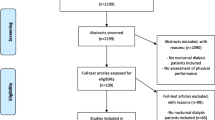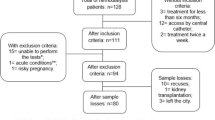Abstract
Summary
We described physical function and activity in UK adults with X-linked hypophosphatemia (XLH). Our data indicate that low physical activity and impaired mobility are common in adults with XLH. Deficits in lower limbs muscle power and functional capacity contribute to the loss of physical function in adults with XLH.
Introduction
There is a dearth of literature on physical function and physical activity in adults with X-linked hypophosphatemia (XLH). We described muscle strength and power, functional capacity, mobility and physical activity level and explored the relationships among these variables in adults with XLH.
Methods
Participants were recruited as part of a UK-based prospective cohort study, the RUDY Study. They underwent a clinical visit and physical examination, including assessment of handgrip strength, jump power (mechanography), six-minute walk test (6MWT) and short physical performance battery (SPPB), and completed the International Physical Activity Questionnaire (IPAQ). Performance data were analysed using parametric and non-parametric tests, whereas correlations were assessed by univariate analysis.
Results
Twenty-six adults with XLH (50% males) with a mean age of 44 ± 16.1 years were recruited. Jump power and 6MWT distances (p < 0.0001) were 54.4% and 38.6% lower respectively in individuals with XLH compared with normative values. These deficits were not associated with age or sex. Handgrip strength values were similar to expected values. Deficits in muscle power were more pronounced than those reported at 6MWT (p < 0.0001). Univariate analysis revealed only a correlation between total physical activity and muscle power (r = 0.545, p = 0.019).
Conclusions
Adults with XLH have a marked deficit in lower limb muscle power and a reduced functional capacity, with a high incidence of impaired mobility and inactivity. In addition to metabolic effects of XLH, low physical activity may contribute to deficits in lower limb power. Further studies are required to develop novel treatment approaches to improve physical function and mobility.

Similar content being viewed by others
Data availability
The authors do not have permission to share the data.
References
Carpenter TO, Imel EA, Holm IA, Jan De Beur SM, Insogna KL (2011) A clinician’s guide to X-linked hypophosphatemia. J Bone Miner Res 26:1381–8. https://doi.org/10.1002/jbmr.340
Pettifor JM (2008) What’s new in hypophosphataemic rickets? Eur J Pediatr 167:493–499. https://doi.org/10.1007/s00431-007-0662-1
Seefried L, Smyth M, Keen R, Harvengt P (2021) Burden of disease associated with X-linked hypophosphataemia in adults: a systematic literature review. Osteoporos Int 32:7–22. https://doi.org/10.1007/s00198-020-05548-0
Forestier-Zhang L, Watts L, Turner A, Teare H, Kaye J, Barrett J et al (2016) Health-related quality of life and a cost-utility simulation of adults in the UK with osteogenesis imperfecta, X-linked hypophosphatemia and fibrous dysplasia. Orphanet J Rare Dis 11:1–9. https://doi.org/10.1186/s13023-016-0538-4
Orlando G, Pinedo-Villanueva R, Reeves ND, Javaid MK, Ireland A (2021) Physical function in UK adults with osteogenesis imperfecta: a cross-sectional analysis of the RUDY study. Osteoporos Int 32:157–164. https://doi.org/10.1007/s00198-020-05537-3
Linglart A, Biosse-Duplan M, Briot K, Chaussain C, Esterle L, Guillaume-Czitrom S et al (2014) Therapeutic management of hypophosphatemic rickets from infancy to adulthood. Endocr Connect 3:R13-30. https://doi.org/10.1530/ec-13-0103
Lo SH, Lachmann R, Williams A, Piglowska N, Lloyd AJ (2020) Exploring the burden of X-linked hypophosphatemia: a European multi-country qualitative study. Qual Life Res 29:1883–1893. https://doi.org/10.1007/s11136-020-02465-x
Veilleux LN, Cheung M, Ben Amor M, Rauch F (2012) Abnormalities in muscle density and muscle function in hypophosphatemic rickets. J Clin Endocrinol Metab 97:1492–8. https://doi.org/10.1210/jc.2012-1336
Steele A, Gonzalez R, Garbalosa JC, Steigbigel K, Grgurich T, Parisi EJ et al (2020) Osteoarthritis, osteophytes, and enthesophytes affect biomechanical function in adults with X-linked hypophosphatemia. J Clin Endocrinol Metab 105:e1798–e1814. https://doi.org/10.1210/clinem/dgaa064
Javaid MK, Forestier-Zhang L, Watts L, Turner A, Ponte C, Teare H et al (2016) The RUDY study platform - a novel approach to patient driven research in rare musculoskeletal diseases. Orphanet J Rare Dis 11:1–9. https://doi.org/10.1186/s13023-016-0528-6
Spruit MA, Sillen MJH, Groenen MTJ, Wouters EFM, Franssen FME (2013) New normative values for handgrip strength: results from the UK Biobank. J Am Med Dir Assoc 14:775.e5-775.e11. https://doi.org/10.1016/j.jamda.2013.06.013
Runge M, Rittweger J, Russo CR, Schiessl H, Felsenberg D (2004) Is muscle power output a key factor in the age-related decline in physical performance? A comparison of muscle cross section, chair-rising test and jumping power. Clin Physiol Funct Imaging 24:335–340. https://doi.org/10.1111/j.1475-097X.2004.00567.x
ATS Committee on Proficiency Standards for Clinical Pulmonary Function Laboratories (2002) ATS statement: guidelines for the six-minute walk test. Am J Respir Crit Care Med 166:111–117. https://doi.org/10.1164/ajrccm.166.1.at1102
Beekman E, Mesters I, Gosselink R, Klaassen MPM, Hendriks EJM, Van Schayck OCP et al (2014) The first reference equations for the 6-minute walk distance over a 10 m course. Thorax 69:867–868. https://doi.org/10.1136/thoraxjnl-2014-205228
Ipaq (2005) Guidelines for data processing and analysis of the International Physical Activity Questionnaire ( IPAQ ) – short and long forms. Ipaq 1–15
Theodore-Oklota C, Bonner N, Spencer H, Arbuckle R, Chen C-Y, Skrinar A (2018) Qualitative Research to explore the patient experience of X-linked hypophosphatemia and evaluate the suitability of the BPI-SF and WOMAC® as clinical trial end points. Value Health 21:973–983. https://doi.org/10.1016/j.jval.2018.01.013
Finol H, De Venanzi F, Pereyra B, Alfonso C, Sánchez J (2001) Effects of phosphorus deficiency on the ultrastructure of the rat fast twitch skeletal muscle. Interciencia 26:62–66
Fuller TJ, Carter NW, Barcenas C, Knochel JP (1976) Reversible changes of the muscle cell in experimental phosphorus deficiency. J Clin Invest 57:1019–1024. https://doi.org/10.1172/JCI108343
Hardy DC, Murphy WA, Siegel BA, Reid IR, Whyte MP (1989) X-linked hypophosphatemia in adults: prevalence of skeletal radiographic and scintigraphic features. Radiology 171:403–414. https://doi.org/10.1148/radiology.171.2.2539609
Smith SHL, Reilly P, Bull AMJ (2020) A musculoskeletal modelling approach to explain sit-to-stand difficulties in older people due to changes in muscle recruitment and movement strategies. J Biomech 98:109451. https://doi.org/10.1016/j.jbiomech.2019.109451
Reeves ND, Spanjaard M, Mohagheghi AA, Baltzopoulos V, Maganaris CN (2008) Influence of light handrail use on the biomechanics of stair negotiation in old age. Gait Posture 28:327–336. https://doi.org/10.1016/j.gaitpost.2008.01.014
Yeung SSY, Reijnierse EM, Trappenburg MC, Hogrel JY, McPhee JS, Piasecki M et al (2018) Handgrip strength cannot be assumed a proxy for overall muscle strength. J Am Med Dir Assoc 19:703–709. https://doi.org/10.1016/j.jamda.2018.04.019
Funding
This work was supported by a research grant from Kyowa Kirin.
Author information
Authors and Affiliations
Corresponding author
Ethics declarations
Ethics approval
All procedures performed in studies involving human participants were in accordance with the ethical standards of the institutional and/or national research committee and with the 1964 Helsinki declaration and its later amendments or comparable ethical standards.
Conflicts of interest
GO and AI were supported by research funding from Kyowa Kirin. MS receives honorarium from Kyowa Kirin and grant funding from Roche Diagnostics.
Additional information
Publisher's note
Springer Nature remains neutral with regard to jurisdictional claims in published maps and institutional affiliations.
Rights and permissions
About this article
Cite this article
Orlando, G., Bubbear, J., Clarke, S. et al. Physical function and physical activity in adults with X-linked hypophosphatemia. Osteoporos Int 33, 1485–1491 (2022). https://doi.org/10.1007/s00198-022-06318-w
Received:
Accepted:
Published:
Issue Date:
DOI: https://doi.org/10.1007/s00198-022-06318-w




